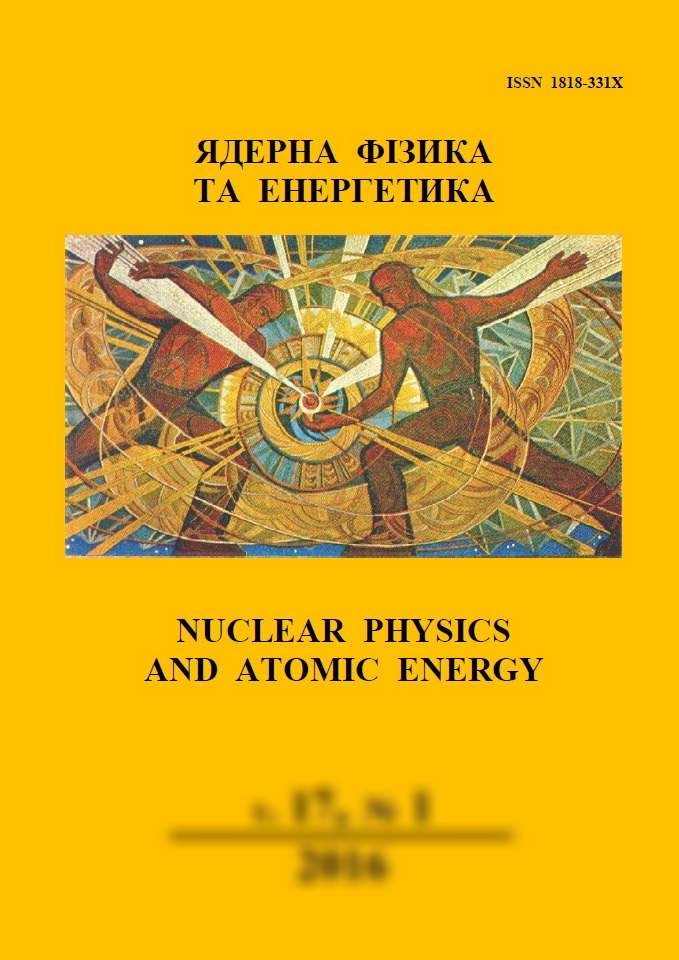 |
ßäåðíà ô³çèêà òà åíåðãåòèêà
Nuclear Physics and Atomic Energy
ISSN:
1818-331X (Print), 2074-0565 (Online)
Publisher:
Institute for Nuclear Research of the National Academy of Sciences of Ukraine
Languages:
Ukrainian, English
Periodicity:
4 times per year
Open access peer reviewed journal
|
Nucl. Phys. At. Energy 2023, volume 24, issue 2, pages 122-130.
Section: Radiation Physics
Received: 20.01.2023; Accepted: 09.05.2023; Published online: 19.06.2023.
 Full text (en)
Full text (en)
https://doi.org/10.15407/jnpae2023.02.122
Oxygen diffusion saturation of hafnium with the different surface layer
V. S. Trush*, I. M. Pohrelyuk, O. H. Luk’yanenko, S. M. Lavrys, T. M. Kravchyshyn
Karpenko Physico-Mechanical Institute, National Academy of Sciences of Ukraine, Lviv, Ukraine
*Corresponding author. E-mail address:
trushvasyl@gmail.com
Abstract:
Hafnium is used for the production of control rods and protective screens in nuclear reactors after its hot plastic deformation and final thermochemical treatment. This research presents the experimental results of the influence of the surface layer state on the oxygen diffusion saturation of hafnium during thermochemical treatment in an oxygen-containing gas medium. Two cases of the surface layer state were considered: in the initial (delivery) state and after grinding, where 50 μm of the surface layer was removed. Differences between the hardness distributions in the near-surface layer of HFE-1 hafnium after thermochemical treatment in an oxygen-containing gas medium were shown. It was found that thermochemical treatment of hafnium with a surface layer in its initial state leads to an increase of hardness in the near-surface layer compared to the surface: i.e., the near-surface layer hardness increases to a depth of 5 - 7 μm, and then gradually decreases to the matrix (core) hardness. It was determined that the fatigue life of hafnium after thermochemical treatment depends on the surface layer state. A 6.5 times higher fatigue life after thermochemical treatment of hafnium samples was fixed with a grinded surface compared to hafnium samples without grinding.
Keywords:
hafnium, thermochemical treatment, oxygen, near-surface layer, hardness, fatigue life.
References:
1. R.H. Nielsen, G. Wilfing. Hafnium and Hafnium Compounds. In: Ullmann’s Encyclopedia of Industrial Chemistry (Weinheim, Wiley-VCH Verlag GmbH & Co. KGaA, 2012) p. 191.
https://doi.org/10.1002/14356007.a12_559.pub2
2. H.W. Keller et al. Development of hafnium and comparison with other pressurized water reactor control rod materials. Nuclear Technology 59(3) (1982) 476.
https://doi.org/10.13182/NT82-A33005
3. V.D. Risovany, E.P. Klochkov, V.B. Ponomarenko. Hafnium in Nuclear Engineering (American Nuclear Society, 2001) 101 p.
Google books
4. M.M. Pylypenko et al. Pure hafnium for nuclear power. Problems of Atomic Science and Technology 1 (2020) 3.
https://vant.kipt.kharkov.ua/ARTICLE/VANT_2020_1/article_2020_1_3.pdf
5. M.L. Kotsar et al. Iodide hafnium. Receipt, composition, properties and application in materials of regulating units of nuclear reactors. Problems of Atomic Science and Technology 2(90) (2014) 78.
https://vant.kipt.kharkov.ua/ARTICLE/VANT_2014_2/article_2014_2_78.pdf
6. A.A. Afanas'ev, Yu.F. Konotop, N.P. Odeichuk. Hafnium is a promising absorber for absorbing elements of the systems of control and protection at VVER-1000 reactors of the NPP of Ukraine. Problems of Atomic Science and Technology 4 (2000) 80. (Rus)
https://vant.kipt.kharkov.ua/ARTICLE/VANT_2000_4/article_2000_4_80.pdf
7. H.H. Wen et al. A Hafnium Material Control Rod Design and Manufacture. Advanced Materials Research 338 (2011) 136.
https://doi.org/10.4028/www.scientific.net/AMR.338.136
8. Yu.F. Konotop, N.P. Odeichuk, V.S. Krasnorutskii. Current State of the Problem of Neutron-Absorbing Materials and Products Made on the Basis of these Materials for the VVER-1000-Type Reactors (Kharkiv, Kharkiv Physical and Technical Institute, 1998) p. 68. (Rus)
https://www.osti.gov/etdeweb/servlets/purl/20158393
9. R.J.H. Clark, D.C. Bradley, P. Thornton. The Chemistry of Titanium, Zirconium and Hafnium (Oxford, England: Pergamon Press, 1975) 151 p.
Book
10. D.A. Negodin et al. Commercial production of metal hafnium and hafnium-based products. Problems of Atomic Science and Technology 78 (2012) 97. (Rus)
https://vant.kipt.kharkov.ua/ARTICLE/VANT_2012_2/article_2012_2_97.pdf
11. D.E. Thomas, E.T. Hayes (Eds.) The Metallurgy of Hafnium. (Naval Reactors, Division of Reactor Development, U. S. Atomic Energy Commission, 1960) 384 p.
Google books
12. J.H. Choi, Y. Mao, J.P. Chang. Development of hafnium based high-k materials - A review. Mat. Sci. and Eng. R: Reports 72 (2011) 97.
https://10.1016/j.mser.2010.12.001
13. I.M. Neklyudov et al. New technology for the production of nuclear-quality hafnium. Nauchnye Vedomosti Belgorodskogo Gosudarstvennogo Universiteta. Ser. Fizika 4(14) (2001) 127. (Rus)
14. H. Jehn, E. Fromm, E. Gebhardt. Gases and Carbon in Metals. Transl. from Germ. (Moskva: Metallurgy, 1980) 712 p. (Rus)
15. I.M. Neklyudov et al. Preparation for the production of hafnium rods. Science and Innovation 6(6) (2010) 5. (Rus)
https://doi.org/10.15407/scin6.06.005
16. D.A. Negodin et al. Commercial production of metal hafnium and hafnium-based products. Problems of Atomic Science and Technology 2(78) (2012) 97. (Rus)
https://vant.kipt.kharkov.ua/ARTICLE/VANT_2012_2/article_2012_2_97.pdf
17. V.S. Krasnorutsky, V.A. Zuyok, N.M. Roenko. Influence of deformation and annealing on structure and texture bar from calciumthermic hafnium. Problems of Atomic Science and Technology 3(86) (2005) 108. (Rus)
https://vant.kipt.kharkov.ua/ARTICLE/VANT_2005_3/article_2005_3_108.pdf
18. I.M. Neklyudov et al. Preparation for the production of constructional materials from hafnium. Science and Innovation 5 (2009) 23. (Rus)
https://doi.org/10.15407/scin5.02.023
19. R.V. Azhazha et al. Influence of annealing on a structure and properties of high temperature rolled hafnium. Problems of Atomic Science and Technology 1(17) (2008) 27. (Rus)
https://vant.kipt.kharkov.ua/ARTICLE/VANT_2008_1/article_2008_1_27.pdf
20. V.M. Fedirko, O.H. Luk'yanenko, V.S. Trush. Influence of the diffusion saturation with oxygen on the durability and long-term static strength of titanium alloys. Mater. Sci. 50 (2014) 415.
https://doi.org/10.1007/s11003-014-9735-2
21. V.M. Fedirko et al. Effect of thermochemical treatment in regulated gas media on the thermal resistance of Zr1%Nb alloy. Mater. Sci. 52 (2016) 209.
https://doi.org/10.1007/s11003-016-9945-x
22. V.N. Fedirko, A.G. Luk'yanenko, V.S. Trush. Solid-Solution Hardening of the Surface Layer of Titanium Alloys. Part 2. Effect on Metallophysical Properties. Metal Science and Heat Treatment 56 (2015) 661.
https://doi.org/10.1007/s11041-015-9818-1
23. V.S. Trush et al. Influence of the functional layer on the operating characteristics of Zr - 1% Nb alloy at a temperature of 380 °C. Mater. Sci. 57 (2021) 234.
https://doi.org/10.1007/s11003-021-00537-y
24. I.M. Pohrelyuk et al. Topography, hardness, elastic modulus and wear resistance of nitride coatings on titanium. In: 9th International Scientific Conference, dedicated to 100th Anniversary of Restitution of Lithuania, Aleksandras Stulginskis University, Kaunas, Lithuania, 16 - 17 November 2017. Proceedings (Kaunas: Aleksandras Stulginskis University, 2017) p. 41.
https://doi.org/10.15544/balttrib.2017.09
25. G.G. Maksimovich. Micromechanical Investigations of the Properties of Metals and Alloys (Kyiv: Naukova Dumka,1974) 243 p. (Rus)
